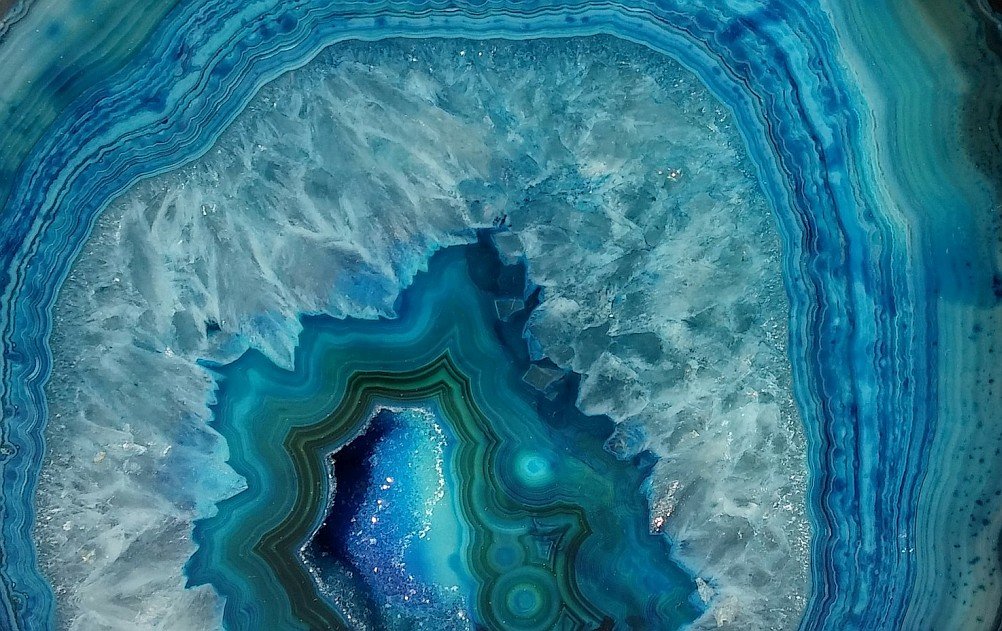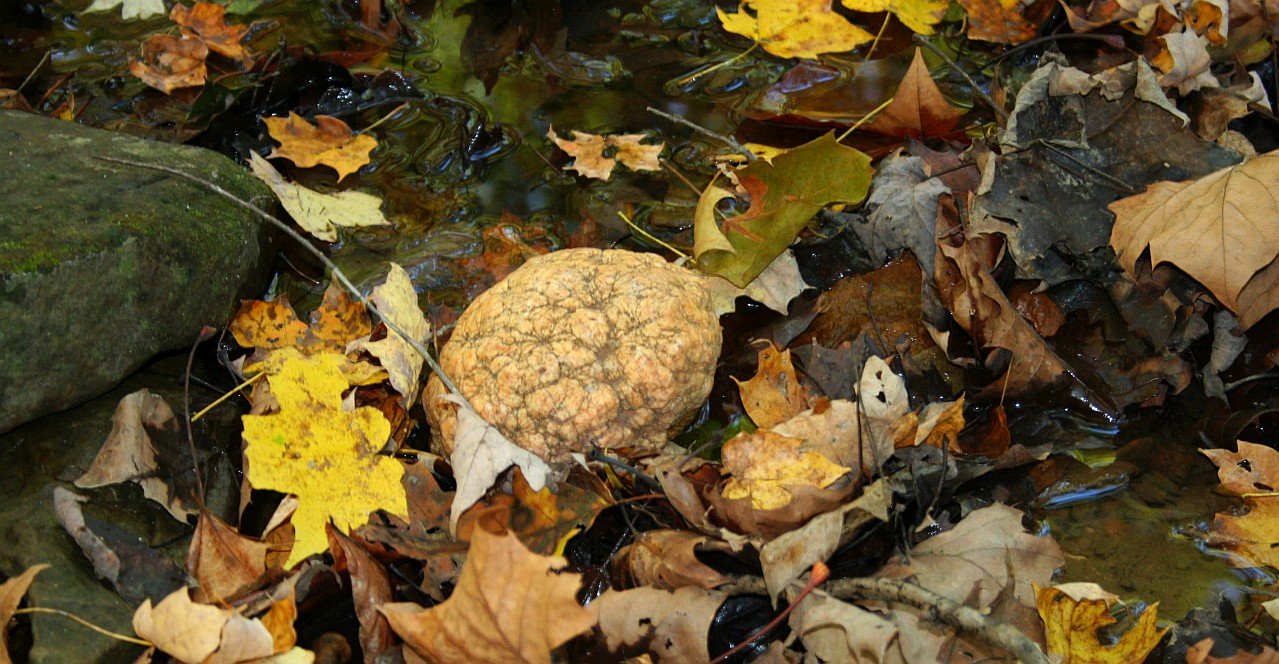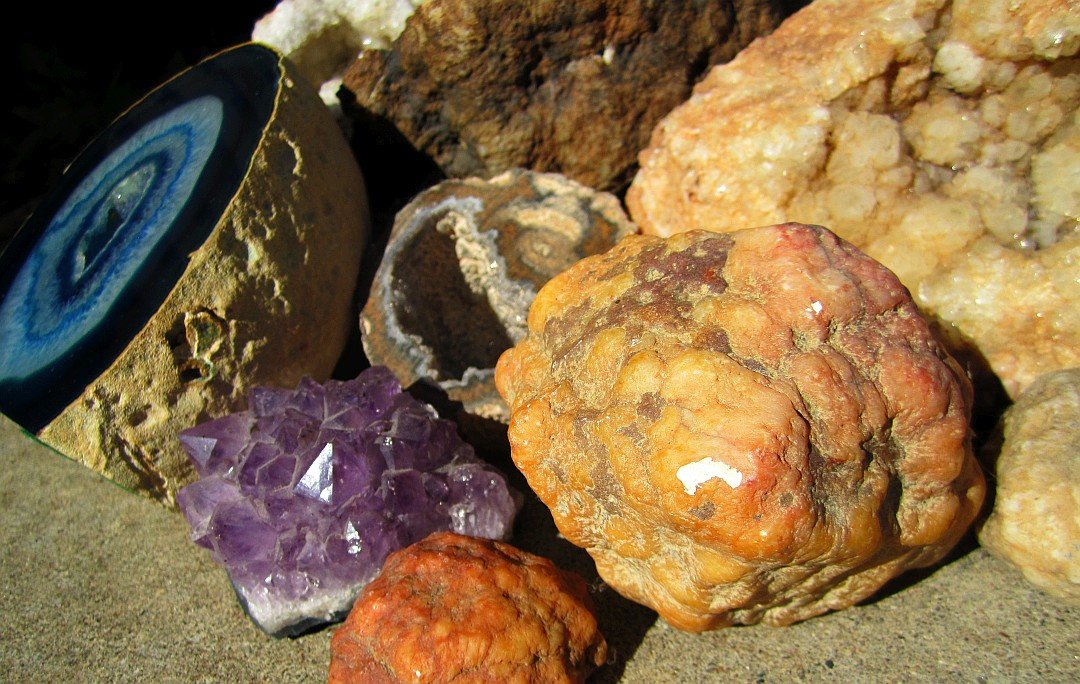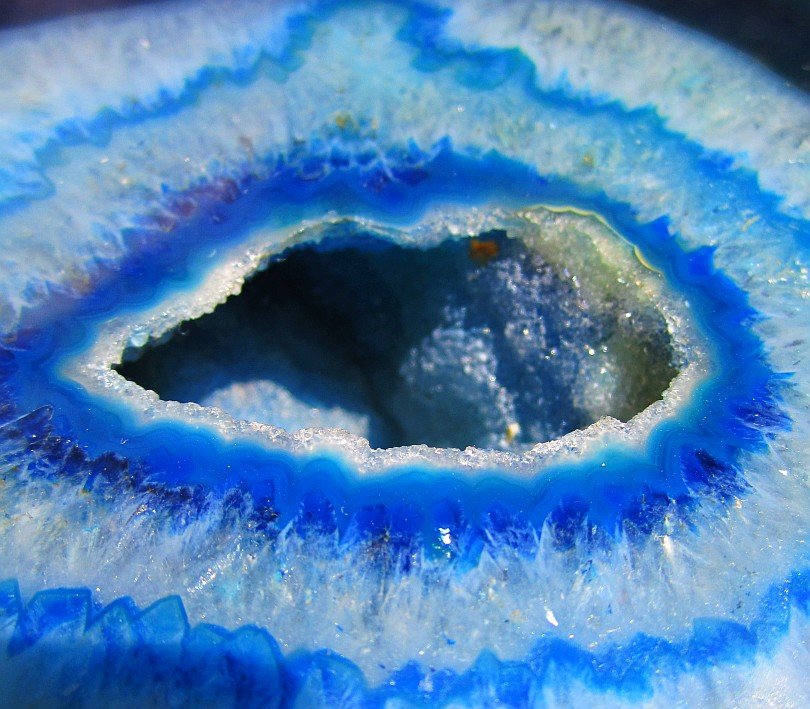
In select creeks and rivers across the world a strange round rock can be found among otherwise flat and angular stones. It may seem unnatural; perhaps some kind of a prank or maybe a toy? If you have a more vivid imagination, perhaps they look like dinosaur eggs or maybe even alien brains. These unique rocky spheres known as geodes are a special type of sedimentary rock that can sometimes have a hidden surprise inside!
 A geode in a creek among less interesting rocks and leaves. (bg)
A geode in a creek among less interesting rocks and leaves. (bg)
Sedimentary Rock
For those unfamiliar with the term, a sedimentary rock is a rock that is formed gradually with the deposition and cementation of sediment. Sedimentary rocks are often made small particles of rock and mineral, ranging in size from large boulders to gravel, sand, silt, clay, or even smaller microcrystalline particles! A few common types of sedimentary rock include limestone, sandstone, shale, conglomerate, and chert.Geode Formation
 Simple animation showing geode genesis. A void space forms when a softer sediment (red) is eroded away. The void is then filled in with successive layers of minerals and crystal growth that precipitates from the water.
Simple animation showing geode genesis. A void space forms when a softer sediment (red) is eroded away. The void is then filled in with successive layers of minerals and crystal growth that precipitates from the water.Geode Varieties
Geodes come in all shapes and sizes, depending on the type of void space that they form in and the dissolved minerals present in the infiltrating water. Geodes can be oblong or irregular in shape, but are most easily recognizable when they are roughly the shape of a sphere. Just a few of the many types of geodes!
Just a few of the many types of geodes!
The largest known geode is an enormous void known as Crystal Cave in northern Ohio. It is over 10 meters long and is tall enough that people can walk through it. On the other extreme, I have found geodes smaller than a marble.

An extreme close up of an agate that formed as a nodule.
If a geode fills in completely, it is technically no longer a geode but rather a nodule. Nodules can be quite beautiful as well, but they will not have the freely growing crystals that many geode hunters seek.
Geode Exposure

Cross-sectional view of a creek (light blue) cutting through limestone (white) and exposing geodes (red). Scales grossly exaggerated!
Not all rock units will produce geodes, and geodes can only be found in certain areas. They are common in limestone deposits in Midwestern USA and also appear in desert regions. Additionally, a dark and fine-grained igneous rock known as basalt can produce geodes, given the right conditions. They can be found in Europe, South America, and even Africa.
Cracking Geodes
Without question, finding and cracking open a beautiful sparkling geode is one of the more exciting experiences that there is. This can lead eager geode hunters to want to break open every geode they can find in a quest for beautiful crystals. While this may be an efficient method for achieving the sought-after prize, it is also quite destructive.
A large geode rich with small quartz crystals
Our public creeks and rivers are a shared resource. If we selfishly take every geode that we can find, there are none left for others to discover. If we wastefully break every geode and keep only the desired ones, there are no more mystical round stones for others to speculate about – only sharp shattered shards discarded by a disrespectful rockhound.

The blue color in this quartz geode is likely artificial dye (a common practice).
If you're hunting geodes, be respectful of others and limit the number you take to a few. Avoid breaking open the geodes until you are at home and are wearing appropriate eye protection! It may take several powerful direct hits with a rock hammer before the geode starts to show cracks. Be careful not to hit the geode too hard at the wrong time or you risk destroying any interior crystal structures! A good test for determining which geodes are worth breaking is to gently shake them. Hollow geodes with crystals inside will often seem unnaturally light in weight and rattle when shaken!
Spatial Data
Perhaps the most efficient way to hunt for geodes is to make use of the multitude of free spatial data available. In my earlier post I discuss the basics of utilizing spatial data to find morel mushrooms. Stay tuned for an upcoming post about finding geodes with the help of GIS!Additional References
Much of the information presented in this article is gleaned from personal experiences and knowledge. Additional references include:
Scienceline.org Geode Formation | Cochise.edu Geode article | GeologyPage Geode article
Hayes, John B. "Geodes and concretions from the Mississippian Warsaw Formation, Keokuk region, Iowa, Illinois, Missouri." Journal of Sedimentary Research 34.1 (1964).
